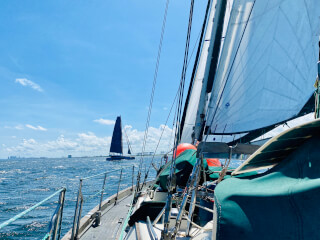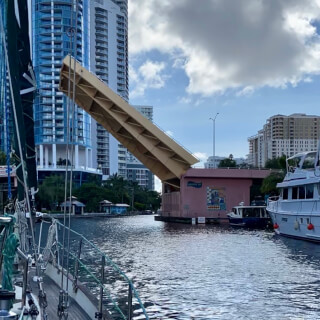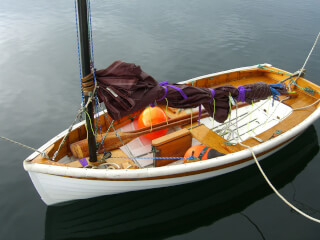Table of Contents

What can you expect from a sea trial?
Before we jump into the sea trial, I referenced a great write-up again by PC Marine Surveys on what to expect on a sea trial. Some key highlights include:
- ensure all engine and steering gear hatches are open for full access underway
- be at the helm when the boat is started to see whether all gauges respond properly
- listen and watch fuel filters/lines, motor mounts, gear engagement, stuffing boxes, hoses, impeller pumps, exhaust systems
- look for leaking hoses, leaking exhaust, excessive movement of stuffing boxes, and shaft vibration
- ensure steering cable, quadrants, hydraulic hoses, tiller arms and/or tie rods are secure and responding appropriately
- upon return, take note of gauges and readings of oil pressure, temperature, volt meter, tachometer
- throttle to full operating temperature and evaluate readings
- raise sails and inspect sails and running rigging
- ensure all winches, clutches, furlers, cars and tracks are operable
- while cruising at idle, run all other systems (stove, water heater, navigation and anything electrical)
- when secured back on the dock, test the windlass and inspect ground tackle
Secrets of a sea trial published in Passage Maker provides an account of what happens when builders conduct a sea trial of a new boat.
Owners are not invited because it could give them pause when they witness running a diesel engine at wide open throttle (both in and out of gear) or cutting doughnuts in the sea by making fullspeed turns with the rudder hard over. The purpose of these sea trials is to shake loose the troubles when the water heater leaks or the lights don’t work and to get them fixed.
Reading these accounts were an eye-opener for us, and we hope you also find these resources useful as well.
How did RJ Slocum fare?
Since we had an earlier than scheduled haul out, we were able to get underway with the sea trial on the same day. Bill turned the helm over to Andrew who steered us out of the canal and onto Stranahan River.
Bill got the main sail ready, unzipping the sail bag and making sure none of the lazy jacks would foul hoisting the sail. He also decided to put a reef in the main. Then, Bill and I ran the furling line through the blocks and then led the jib sheets aft to the cockpit.
Winds were 13-15 knots from the northeast. Swells were 3 feet high and about 5 seconds apart as we motored out Stranahan River and into the Atlantic. As Bill assessed the wind condition, he decided to deploy the staysail first and then let out the jib. We mostly let Bill handle all the lines except when he needed help.
It seemed quite a bit of the running rigging was tight. (Bill later discovered one of the staysail blocks had fallen off. Luckily, he has a spare.) Cranking on the winch seemed to yield very little progress, and I wonder if this was due to the fact that she hadn’t been sailed for over a year. Are these the typical sounds one would hear? (Ian’s survey write-up indicated all the winches and clutches should be cleaned and greased.)
Once both sails were out and we were on a starboard tack (close reach), we cut the motor and we were sailing!
From the deck, Ian had a look at the rigging. Given the standing rigging was redone in South Africa 3 years ago, he didn’t go aloft. He did notice cotter pins missing in the turnbuckle of the backstays and pointed this out to Bill.
When Ian was back in the cockpit, we tacked and set a course for Dania Beach to test the ground tackle. We sailed on a close reach for about an hour. Andrew and I each had turns at the helm while Ian and Bill went down below to test and evaluate the systems.
These 90 minutes of sailing was by far the highlight of our day. After dropping anchor for a test of the windlass and evaluation of the chain’s condition, we motored back into the marina arriving as the sun set.
It turned out to be the longest sea trial ever. If you want to read more about the survey and sea trial, we’ll capture what happened behind-the-scenes in a future post.

Survey results
On Friday, Andrew and I had just finished breakfast from Bake Shack on the rooftop of our hotel. He stayed to have a smoke while I went back to the room. He forwarded the survey findings from Ian, and I scanned the contents, jumping straight to the recommendations.
There were over a dozen items listed, none of which were deal-breakers or cause for concern. I then started to research the costs to have these items replaced and tallied them up by the time Andrew got back to the room. We went over the spreadsheet and decided we wanted to run by some questions with Ian, hoping to clear them up over the weekend.
We made plans with Bill and Raquel to check out the dinghy on Saturday morning and then arranged to meet Ian late afternoon to ask questions about the survey.

Launch dinghy
As you know, International Talk Like a Pirate Day was on September 19th, and it turns out that was the same day that we wanted to deploy the dinghy, which would allow us, in part, to “swab the decks.” Aaaarrgh!
Bill and Andrew handled the myriad of steps to set up the crane, upend the dinghy, hoist her off the deck, and drop her in the water. As we progressed through each of the steps, fastening points (e.g., cleats, shackles, lines) and their uses revealed themselves. At first blush, all these little features would not make sense except when put to use. Andrew and I enjoyed this discovery each step of the way, as marked by our occasional exclamation.
Once the deck was cleared of the kayak and the dinghy, Raquel got to work hosing down the deck, while I went down below to take meticulous measurements of the fridge & freezer boxes as well as the stowage for the compressor and other components related to the refrigeration system.
Bill and Andrew also uncovered other small boat projects: fixing the existing car on the staysail boom and attaching a new block, replacing eyelets on the dinghy, etc. It was our first exposure to another aspect of daily life aboard a sailboat…endless boat jobs.
Four hours later, we were well-past lunch, and I checked in with Andrew on what we wanted to accomplish for the rest of the day. While we could easily spend the rest of the day on the boat, we needed to do laundry and more importantly meet with Ian.

Survey Q&A
After exchanging a few text messages, we met up with Ian for beers at Tarpon River Brewing. This spot had been a favorite of ours since we first came across it a few days earlier. So we had a late lunch of firecracker shrimp and shrimp po boy while we cooled off, rested and recapped the week.
Ian came by at 4:30, and over the course of a few hours, we talked about sailing and life as well as went over the survey findings. In the end, it was helpful to have a neutral 3rd party weigh in as a sanity check, especially since this is a sizeable amount of money.
Typically, buyers would have a buyers broker in place to define what is reasonable and what to push back on. Until this point, we haven’t seen the need for one, and we still don’t. We’ll use the survey results to negotiate the final price.
What’s next?
Over the next few days, we’ll be negotiating the deal as well as tackling some repairs (stanchion, windvane paddle) and upgrades (refrigeration), arrange dockage for RJ Slocum in the near term and schedule a second haul out for bottom paint, buffing sides and other repairs when we return to Ft. Lauderdale.
More from this series:
- Survey & Sea Trial Part 1
- Survey & Sea Trial Part 2
- Survey & Sea Trial Part 3
- Survey & Sea Trial Part 4
- Survey & Sea Trial Part 5
Thanks for reading!
Share Survey & Sea Trial Part 4 with your friends:
Stay up to date with our content releases, by subscribing to our RSS Feed or follow us on Facebook and Instagram.
 If you would like to delve deeper into our adventure as it unfolds, please consider joining the Serenade Wind Crew. Our sister site provides more information on what it means to be part of the crew, unlock the pirate’s booty, and receive other exclusive access and benefits.The first 50 members have a gift waiting.
If you would like to delve deeper into our adventure as it unfolds, please consider joining the Serenade Wind Crew. Our sister site provides more information on what it means to be part of the crew, unlock the pirate’s booty, and receive other exclusive access and benefits.The first 50 members have a gift waiting. 